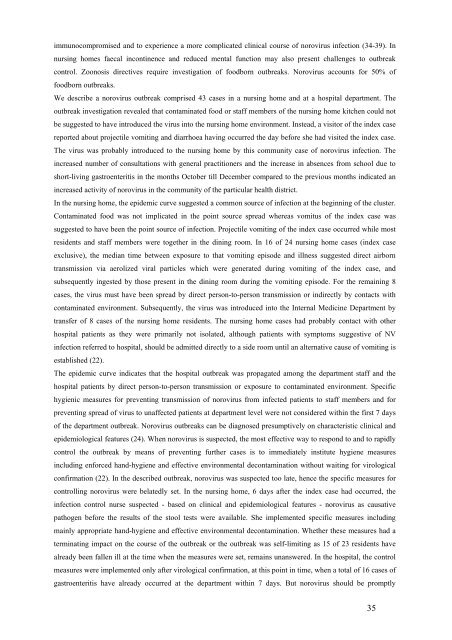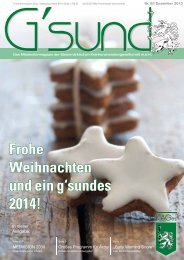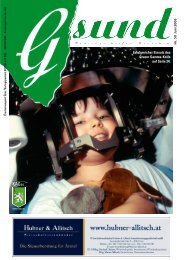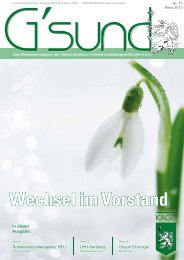Jahresbericht - Gesundheitsserver - Land Steiermark
Jahresbericht - Gesundheitsserver - Land Steiermark
Jahresbericht - Gesundheitsserver - Land Steiermark
Sie wollen auch ein ePaper? Erhöhen Sie die Reichweite Ihrer Titel.
YUMPU macht aus Druck-PDFs automatisch weboptimierte ePaper, die Google liebt.
immunocompromised and to experience a more complicated clinical course of norovirus infection (34-39). In<br />
nursing homes faecal incontinence and reduced mental function may also present challenges to outbreak<br />
control. Zoonosis directives require investigation of foodborn outbreaks. Norovirus accounts for 50% of<br />
foodborn outbreaks.<br />
We describe a norovirus outbreak comprised 43 cases in a nursing home and at a hospital department. The<br />
outbreak investigation revealed that contaminated food or staff members of the nursing home kitchen could not<br />
be suggested to have introduced the virus into the nursing home environment. Instead, a visitor of the index case<br />
reported about projectile vomiting and diarrhoea having occurred the day before she had visited the index case.<br />
The virus was probably introduced to the nursing home by this community case of norovirus infection. The<br />
increased number of consultations with general practitioners and the increase in absences from school due to<br />
short-living gastroenteritis in the months October till December compared to the previous months indicated an<br />
increased activity of norovirus in the community of the particular health district.<br />
In the nursing home, the epidemic curve suggested a common source of infection at the beginning of the cluster.<br />
Contaminated food was not implicated in the point source spread whereas vomitus of the index case was<br />
suggested to have been the point source of infection. Projectile vomiting of the index case occurred while most<br />
residents and staff members were together in the dining room. In 16 of 24 nursing home cases (index case<br />
exclusive), the median time between exposure to that vomiting episode and illness suggested direct airborn<br />
transmission via aerolized viral particles which were generated during vomiting of the index case, and<br />
subsequently ingested by those present in the dining room during the vomiting episode. For the remaining 8<br />
cases, the virus must have been spread by direct person-to-person transmission or indirectly by contacts with<br />
contaminated environment. Subsequently, the virus was introduced into the Internal Medicine Department by<br />
transfer of 8 cases of the nursing home residents. The nursing home cases had probably contact with other<br />
hospital patients as they were primarily not isolated, although patients with symptoms suggestive of NV<br />
infection referred to hospital, should be admitted directly to a side room until an alternative cause of vomiting is<br />
established (22).<br />
The epidemic curve indicates that the hospital outbreak was propagated among the department staff and the<br />
hospital patients by direct person-to-person transmission or exposure to contaminated environment. Specific<br />
hygienic measures for preventing transmission of norovirus from infected patients to staff members and for<br />
preventing spread of virus to unaffected patients at department level were not considered within the first 7 days<br />
of the department outbreak. Norovirus outbreaks can be diagnosed presumptively on characteristic clinical and<br />
epidemiological features (24). When norovirus is suspected, the most effective way to respond to and to rapidly<br />
control the outbreak by means of preventing further cases is to immediately institute hygiene measures<br />
including enforced hand-hygiene and effective environmental decontamination without waiting for virological<br />
confirmation (22). In the described outbreak, norovirus was suspected too late, hence the specific measures for<br />
controlling norovirus were belatedly set. In the nursing home, 6 days after the index case had occurred, the<br />
infection control nurse suspected - based on clinical and epidemiological features - norovirus as causative<br />
pathogen before the results of the stool tests were available. She implemented specific measures including<br />
mainly appropriate hand-hygiene and effective environmental decontamination. Whether these measures had a<br />
terminating impact on the course of the outbreak or the outbreak was self-limiting as 15 of 23 residents have<br />
already been fallen ill at the time when the measures were set, remains unanswered. In the hospital, the control<br />
measures were implemented only after virological confirmation, at this point in time, when a total of 16 cases of<br />
gastroenteritis have already occurred at the department within 7 days. But norovirus should be promptly<br />
35
















